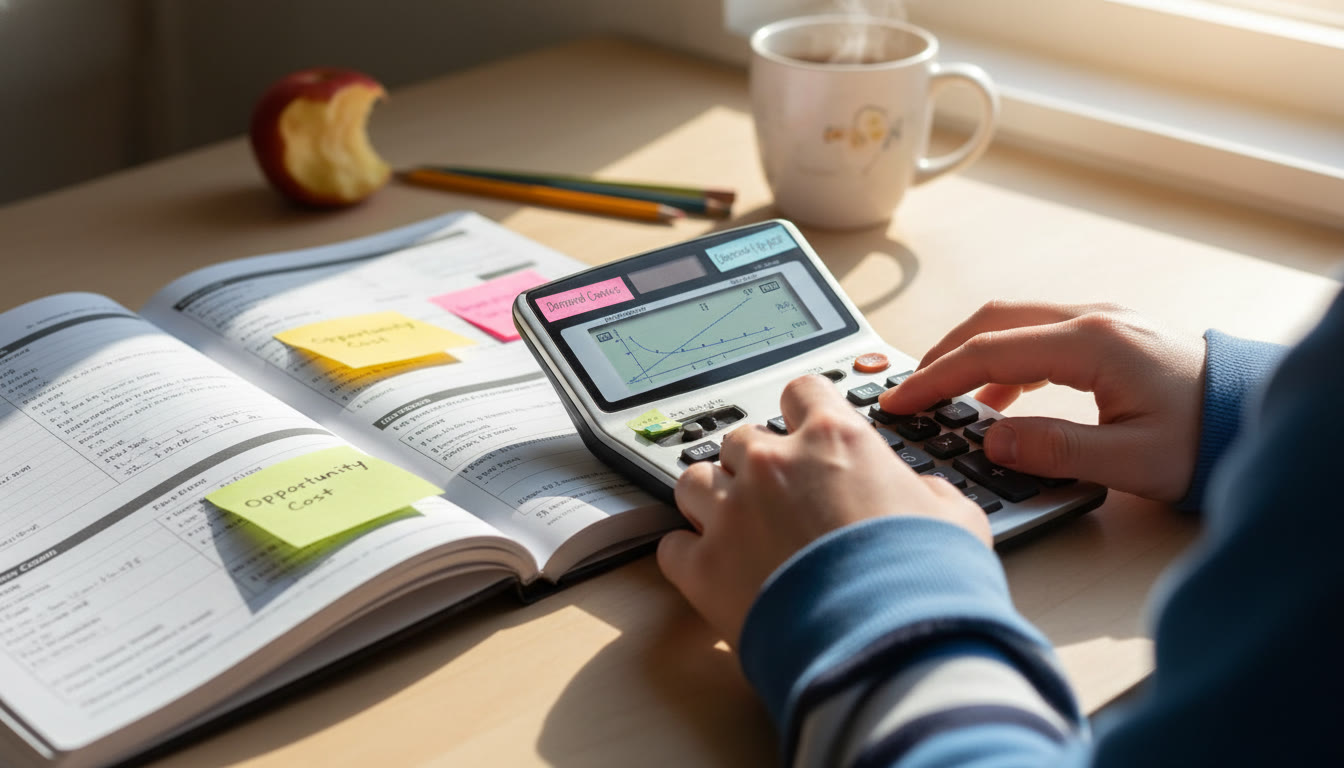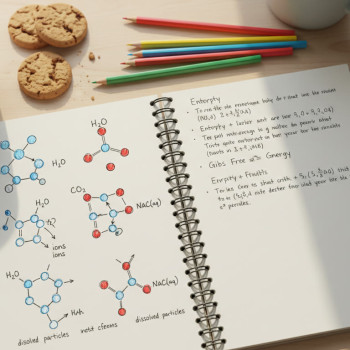Why an Econ Calculator Won’t Solve Your Panic
If you’ve ever stared at an AP Economics free-response question, reached for your calculator, and somehow managed to get the arithmetic wrong anyway, welcome to the club. The calculator is powerful: it can crunch numbers, store values, and check your work. But calculators can’t fix shaky fundamentals, sloppy setup, or test-time panic. They also don’t rescue answers when the algebra is right but you keyed in a wrong sign, misread a decimal place, or forgot to convert units.

The gap between ‘Can calculate’ and ‘Calculate correctly under pressure’
There are three common reasons bright students make simple arithmetic mistakes on AP Econ exams:
- Setup errors: Putting the wrong numbers into the right formula, or right numbers into the wrong spot.
- Entry errors: Typing mistakes, misplaced decimals, forgotten parentheses, or sign errors when using a calculator.
- Conceptual mismatch: Knowing how to manipulate an equation in class but misapplying it in a test context—especially when time is short.
Solving these doesn’t require you to become a human calculator. It takes clearer habits, smarter use of tools, and a few practical strategies to keep your head when numbers get noisy.
Foundations: Small Habits That Prevent Big Errors
Before diving into techniques, establish a few simple habits that reduce arithmetic mistakes dramatically.
1. Write every step—yes, every step
Neat, consistent steps do two things: they make mistakes visible and they allow partial credit when the final answer is wrong. On AP exams, graders reward reasoning; showing steps turns a careless slip into an opportunity for points.
2. Round only when appropriate
Rounding too early causes drift. If a question asks for two decimal places, carry at least three or four through your work and round on the final line. When using the calculator, use full precision until the end.
3. Use parentheses and check order of operations
Parentheses save lives—figuratively and numerically. When an expression includes subtraction or division mixed with addition or multiplication, group terms so the calculator interprets them exactly as you intend.
4. Label values and units
Write down what each number represents (e.g., “P = 12.5 dollars” or “Q = 40 units”). This prevents swapping a tax per unit for a total tax, or mistakenly plugging price for quantity.
Smart Calculator Strategy: How to Use It Without Letting It Use You
Your calculator is an ally; treat it like a colleague who needs clear instructions. Here’s how to set up routines that use the device’s strengths while minimizing entry mistakes.
Memory Is Your Friend
Rather than retyping complicated intermediate results, store them in memory variables (M+, STO) and recall when needed. This reduces transcription errors and preserves full precision.
Check Your Work Twice
Always do a quick mental or paper-based sanity check after the calculator gives an answer. For example, if you expect a price elasticity around -1 and your result is -100, stop and re-evaluate the inputs.
Use Reverse Calculations
If you compute an equilibrium price, plug that price back into the supply and demand equations to confirm the quantities match. Reverse-checking turns one arithmetic operation into two safety nets.
Test-Time Routines: Calm, Fast, and Accurate
When the clock is ticking, routines provide structure and reduce the cognitive load. Adopt a short checklist you run through whenever numbers come up.
Five-Second Sanity Check
- Are units consistent? (dollars per unit vs total dollars)
- Did I copy the numbers correctly from the prompt?
- Are parentheses and negative signs in the right place?
Three-Second Entry Routine
Before pressing equals, quickly glance back at the expression and read it out loud in your head. The act of reading often catches transposition or misplaced decimal errors.
Common AP Economics Arithmetic Traps and How to Avoid Them
AP Micro and Macro questions often hide arithmetic pitfalls inside otherwise straightforward economic reasoning. Below are frequent traps with concrete fixes.
Trap: Misreading Per-Unit vs Total Values
Scenario: A tax of $2 per unit is introduced. Students sometimes subtract $2 from total revenue instead of adjusting the price in the demand function.
Fix: Always ask yourself whether the value in the problem is a ‘rate’ (per unit) or a ‘total.’ Label your variable accordingly: t = $2/unit, T = $2 total.
Trap: Forgetting to Convert Percentages
Scenario: Elasticity and growth rates often appear as percents (e.g., 5%). Using 5 instead of 0.05 will magnify your result by 100x.
Fix: When you see a % sign, rewrite it as a decimal before plugging into formulas. A quick habit is to write the decimal next to the percent in your scratch work.
Trap: Sign Errors with Supply and Demand Slopes
Scenario: A downward-sloping demand curve has a negative slope. Students sometimes use the slope without its negative sign in calculations of elasticity, consumer surplus, or equilibrium shifts.
Fix: Explicitly write the functional form with signs: e.g., P = 50 – 2Q. When rearranging for Q, carry the negative sign through every step and use parentheses when plugging into the calculator.
Practical Worked Example: Equilibrium, Tax, and Deadweight Loss
Let’s walk through a typical AP-style question and keep the arithmetic tidy.
The Problem (shortened)
Demand: P = 100 – 2Q. Supply: P = 20 + 3Q. A $10 per-unit tax is introduced on sellers. Find the pre-tax equilibrium price and quantity, the post-tax buyer price and seller price, quantity after tax, and deadweight loss (DWL).
Step-by-step solution with arithmetic habits
1) Pre-tax equilibrium: set demand = supply.
- 100 – 2Q = 20 + 3Q
- Move terms: 100 – 20 = 3Q + 2Q → 80 = 5Q → Q* = 16
- Plug into demand for P*: P* = 100 – 2(16) = 100 – 32 = 68
2) After $10 tax on sellers, supply curve shifts up by $10: P = (20 + 10) + 3Q = 30 + 3Q (this P is price paid to sellers; buyers pay Pb where Pb = Ps + tax).
- Set demand equal to buyer price: Pb = 100 – 2Q. But Pb = Ps + 10 = (30 + 3Q) + 10 = 40 + 3Q.
- 100 – 2Q = 40 + 3Q → 60 = 5Q → Q_after = 12
- Buyer price Pb = 100 – 2(12) = 100 – 24 = 76
- Seller price Ps = Pb – 10 = 66 (or plug Q into Ps = 30 + 3(12) = 66 to confirm)
3) DWL calculation (triangular area): DWL = 0.5 × tax × (Q_before – Q_after) = 0.5 × 10 × (16 – 12) = 0.5 × 10 × 4 = $20.
Table: Quick reference of key numbers
| Item | Value | Notes |
|---|---|---|
| Pre-tax Quantity (Q*) | 16 | Set demand = supply |
| Pre-tax Price (P*) | $68 | Plug Q* into demand |
| Post-tax Quantity | 12 | Shift supply up by $10 and solve |
| Buyer Price (Pb) | $76 | Price paid by buyers after tax |
| Seller Price (Ps) | $66 | Price received by sellers after tax |
| Deadweight Loss (DWL) | $20 | 0.5 × tax × reduction in Q |
Notice how labeling and a small reverse check (plugging Q into Ps = 30 + 3Q) avoids sign confusion and reassures you that both buyer and seller prices line up. These are the kinds of routines that turn a shaky calculation into a confident one.
How to Practice So You Don’t Freeze on Exam Day
Practice must be intentional. Mindless repetition solidifies mistakes; targeted practice corrects them. Here’s a plan that balances skill-building with exam strategy.
Weekly Practice Framework
- 3 targeted problem sets per week focusing on different themes (elasticity, taxes/subsidies, market equilibrium, consumer/producer surplus).
- One timed FRQ (free-response question) every week to build speed and step-showing discipline.
- Daily 15-minute calculator drills: practice memory storage, percentage conversions, parentheses, and reverse checks.
Two Drills That Help More Than You Think
- Backward Plugging: After solving for an equilibrium price, always plug it back into both original equations immediately to confirm equal quantities. This catches algebraic sign slips and entry errors.
- Unit Awareness Drill: Create quick flashcards with common AP phrases like “per unit tax,” “lump-sum subsidy,” and “nominal vs real” and practice converting phrases into labeled variables (e.g., t = $/unit, S = total $) in under 30 seconds.
When to Rely on Human Help: The Value of Personalized Tutoring
Even the best self-study routines have blind spots. Personalized tutoring can shorten your improvement curve by identifying recurring mistakes, tailoring practice to your weak spots, and simulating test-time conditions.
What Personalized Tutoring Provides
- 1-on-1 guidance focused on the exact topics you struggle with (e.g., elasticity math, consumer surplus calculations).
- Tailored study plans that balance content review with arithmetic fluency practice.
- Expert tutors who explain why specific mistakes recur and how to fix them in a way that fits your thinking style.
- AI-driven insights that point out patterns—like frequent sign errors or decimal drift—so you don’t waste time on what you already know.
For students preparing for AP Economics, Sparkl’s personalized tutoring can be a game-changer because it pairs human feedback with data-driven practice. A tutor can show you how to set up every calculation clearly and coach the mental routines that translate to exam confidence.
Real-World Contexts That Make the Arithmetic Stick
Math feels less abstract when anchored to real-world decisions. Here are three examples that make AP Econ arithmetic meaningful and memorable.
1. Fuel Taxes and Commuter Choices
Modeling how a per-gallon tax affects gasoline demand makes price elasticity tangible. Students who calculate how price changes alter commuting costs often remember the percent change conversions better because they can relate to commuting budgets.
2. Minimum Wage and Employment
Working through supply and demand with wages as the price variable gives context to surplus and deadweight loss. Arithmetic errors become easier to spot when you can interpret whether a result implies “more unemployment” or “higher total wages.”
3. Tariffs and Domestic Prices
Tariff calculations (import price adjustments, consumer price increases, producer gains) are arithmetic-heavy. Anchoring these to everyday goods—like the effect of a tariff on imported phones—keeps the math grounded.

Checklist: Pre-Exam Arithmetic Confidence
Use this short checklist the night before or the morning of the exam to prime your arithmetic accuracy.
- Charge your calculator and bring spare batteries.
- Practice 5 quick algebra manipulations and one FRQ under timed conditions.
- Review common conversions: percent-to-decimal, per-unit vs total, and sign conventions for slopes.
- Pack scratch paper and a small ruler to draw neat axes for graph questions.
- Run a 60-second memory check: can you re-derive the formulas for elasticity and DWL without looking?
Final Thoughts: Confidence Is a Skill You Can Practice
Arithmetic errors in AP Economics are rarely a sign you’re “bad at math.” They’re a sign your routines, tool use, or exam habits need refinement. By writing clear steps, using your calculator smartly, and practicing targeted drills, you can turn arithmetic into an advantage rather than a liability.
If you find persistent patterns of mistakes, consider guided help. A few sessions of focused, personalized tutoring—like the support Sparkl provides—can identify blind spots and replace shaky habits with reliable routines, so your calculator becomes a trusted ally, not a crutch you trip over.
Parting Tip
Next time you catch a tiny arithmetic slip in practice, celebrate it. Every spotted mistake is a lesson spared on test day. Prioritize clarity over speed, and let disciplined habits—and the occasional expert nudge—carry you calmly through the exam problems that once made you freeze.
Good luck, and remember: the numbers are on your side when you give them the respect of a tidy setup and a quick double-check.
























No Comments
Leave a comment Cancel